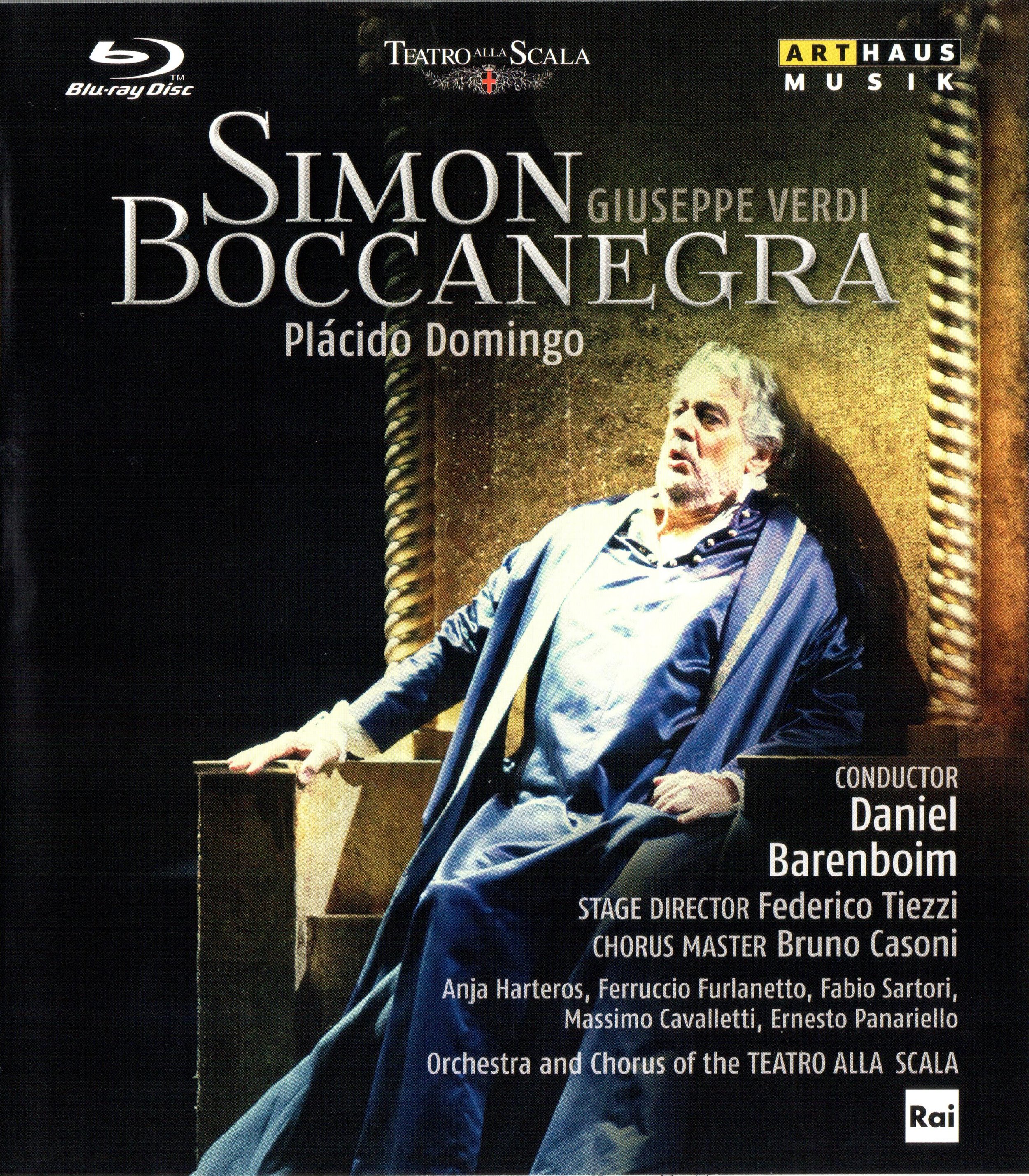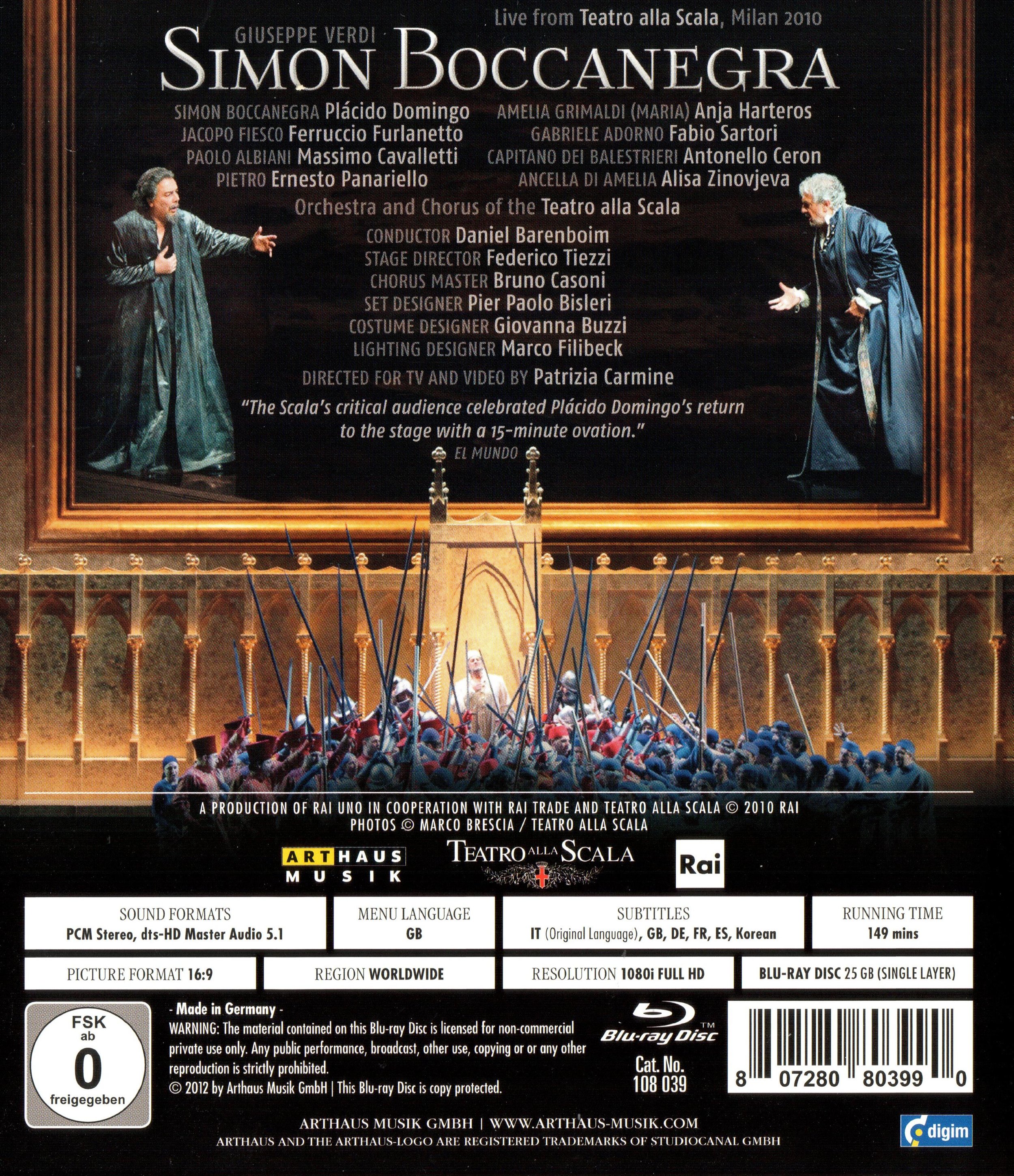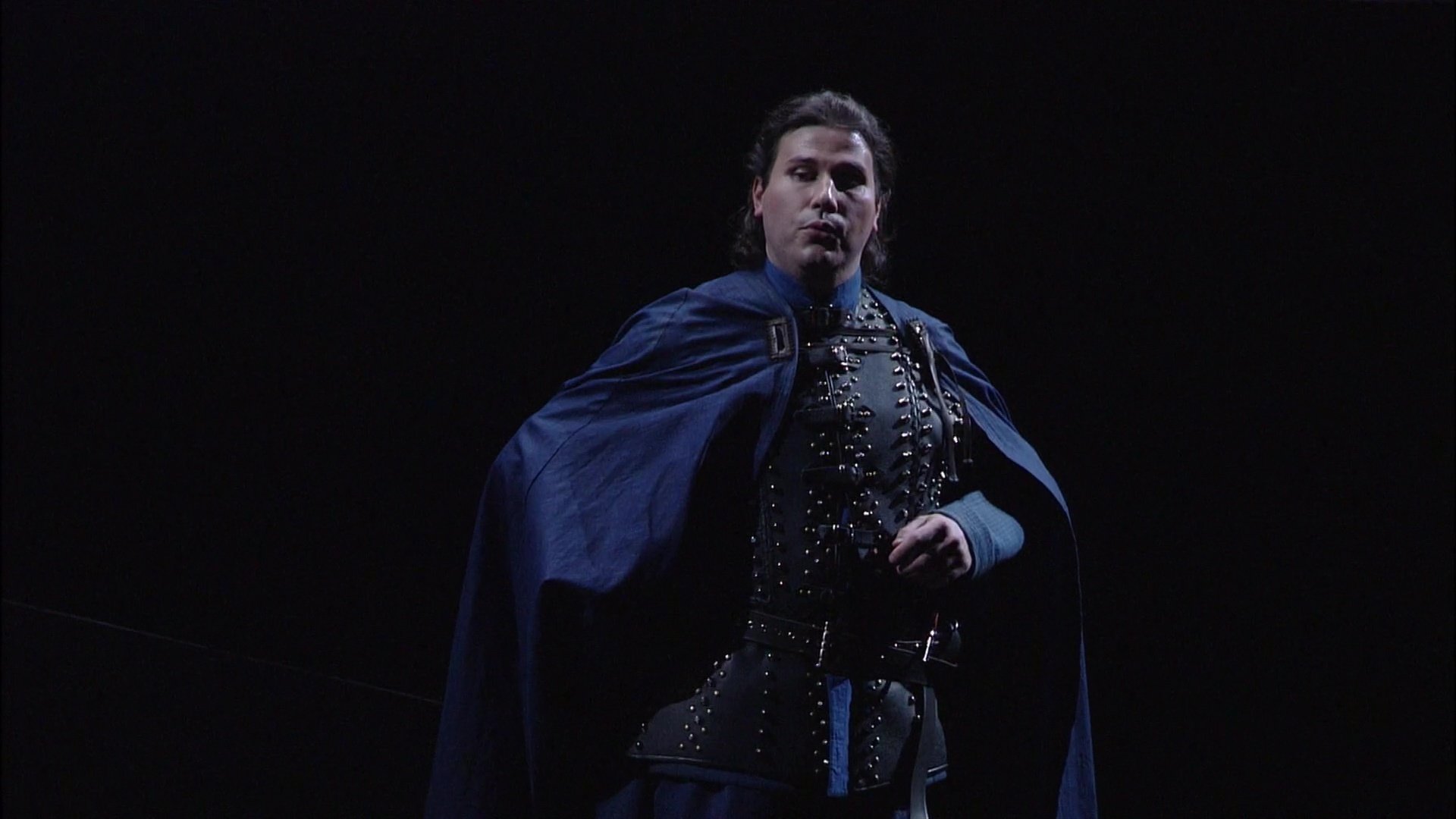

Verdi Simon Boccanegra opera to a libretto by Francesco Maria Piave and later revised by Arrigo Boito. Directed 2010 by Federico Tiezzi at the Teatro alla Scala. Stars Plácido Domingo (Simon Boccanegra), Ferruccio Furlanetto (Jacopo Fiesco), Massimo Cavalletti (Paolo Albiani), Ernesto Panariello (Pietro), Anja Harteros (Amelia Grimaldi (Maria)), Fabio Sartori (Gabriele Adorno), Antonello Ceron (Capitano del balestrieri), and Alisa Zinovjeva (Ancella di Amelia). Daniel Barenboim conducts the Orchestra and Chorus of the Teatro alla Scala (Chorus Master Bruno Casoni). Set design by Pier Paolo Bisleri; costume design by Giovanna Buzzi; lighting design by Marco Filibeck. Directed for TV by Patrizia Carmine. Sung in Italian. Released 2012, disc has 5.1 dts-HD Master Audio sound. Grade: A
If you are not a Verdi expert, you may find this opera hard to follow. For help, see my synopsis at the end of this review. You have to be sharp to follow the plot (even with help). I hope my screenshots will help you learn who is who.
Simon Boccanegra is a melodrama inspired by the life and death of Simon Boccanegra, who was elected Doge of Genoa in 1339. Rivals eventually killed him with poison at a banquet. If you are looking for a traditional Boccanegra with period-looking costumes and impressive sets, this title is for you. Barenboim was arguably the most famous conductor in the world, and La Scala is the premier opera house in the country that invented opera. Plácido Domingo was maybe the most famous tenor in the world, but this was one of his early roles as a baritone. Now to some screenshots.
Domingo as Boccanegra, a plebeian:
Next below Ferruccio Furlanetto as the patrician Jacopo Fiesco. He is Boccanegra’s nemisis:
A younger man is Massimo Cavalletti as our villain Paolo Albiani, also a plebeian. Paolo initially is a key supporter who helps Boccanegro become Doge. Later he plots against the Doge after the Doge denies him the hand of Amelia in marriage:
And here’s Amelia (Anja Harteros) with her lover, Gabriele Adorno, played by Fabio Sartori. I had a little trouble accepting that Sartori will go on to become the first 350-pound Doge of Genoa:
And here’s Boccanegra and Amelia in the scene where they discover they are father and daughter:
La Scala made a big investment here in staging, costumes, and a big chorus. Bigwigs in a box are joined by heralds:
The election of Boccanegra as Doge, who was supported by the sailors in Boccanegra’s pirate fleet and the plebeians:
Next the famous council chamber scene. The giant painting is Caspar David Friedrich’s Das Eismeer (The Frozen Sea), which was considered by the director’s team to be a symbol of the ultimate futility of great power:
A brilliant shot by TV director Patrizia Carmine depicting strife between the social classes. I first saw this in 2012. About 9 years later, I was reminded of this scene by events that took place at the United States Capitol on January 6, 2021:
The traitor Paolo is tricked by Boccanegra into putting a curse on himself! The horror!
The execution of Paolo:
The reconciliation of the patricians and plebeians as Boccanegra is dying from being poisoned:
There were many print reviews —all over the place— about this live show and the recording. I never found a decent YouTube trailer in high-definition video. In 2022 I watched this again. It’s a hoot. But for me the melodrama tends to obscure the messages that Verdi was trying to deliver. I give it an A for anyone who thirsts for sets, costumes, greasepaint, famous personalities, and a 350-pound Doge.
Synopsis
Simon Boccanegra surely has one of the trickiest librettos in opera. It has 5 lead roles for men who tend to look and sound alike (mostly baritones and basses). As to females, there is only 1 lead singing role plus minor mute roles as young females and corpses. The plot covers decades. Many plot elements are revealed only through brief passages in the text or must be figured out by an astute observer. The Arthaus keepcase booklet does not have a synopsis. So if you are not already a Simon Boccanegra expert, this may help you get up to speed:
Prologue
It's the 14th century when Italians were divided into patricians (rich) and plebeians (not so rich). Each city state in Italy is in often at war with other city states. We are in Genoa, which is at war with Venice.
Boccanegra, a heroic naval mercenary (pirate) for Genoa, is a plebeian. In the past, he had a love affair with Maria, the daughter of Jacopo Fiesco, a patrician. Maria had a girl out of wedlock. Furious that Maria had an affair with a plebeian, Fiesco imprisoned Maria in his palace. But Boccanegra got possession of the baby and sent her to live with an old woman in a village on the coast. Boccanegra visited his daughter from time to time from shipboard. In his last visit, the woman had died and his daughter had disappeared.
Boccanegra continues to love the imprisoned Maria. It came time to elect a new Doge, the ruler of Genoa. Paolo, a goldsmith, proposes that Boccanegra should be elected Doge. Boccanegra is persuaded to serve when Paolo points out that Boccanegra would be able to marry Maria if he becomes the Doge. Paolo goes off with Pietro, a plebeian politician, to drum up support for Boccanegra in the election. Fiesco appears, mourning the fact that Maria has just died. Fiesco encounters Boccanegra but does not tell him that Maria is dead. Boccanegra offers to reconcile. But Fiesco says this will only be possible if Boccanegra gives up the baby girl. Boccanegra explains to Fiesco that he can't produce her because she is lost.
The encounter between Boccanegra and Fiesco is over. Boccanegra sees that the door to the Fiesco palace is open and unguarded. He wanders in and discovers the body of the deceased Maria. In grief he asks for a tomb. At the same time a crowd appears celebrating his new throne. Boccanegra is now ruler of Genoa. But his love and daughter are gone. And Fiesco is his implacable enemy.
[Interlude—-not part of the libretto!]
[25 years passes before Act 1 begins. Boccanegra remains the Doge. He tries to create a stable and just state as a plebeian. He exiles Fiesco and other patricians and confiscates their property. But Fiesco is clever. He returns to Genoa and resides with the patrician Grimaldi family in their palace under the name of Andrea Grimaldi. It just happens that the Grimaldi family has no heirs (their sons having been exiled). So to have an heir, the Grimaldis adopt a girl of unknown parentage being sheltered in a convent. They give her the name Amelia Grimaldi. But, unknown to anyone, Amelia is in fact the lost daughter of Boccanegra and the lost granddaughter of Fiesco. Eventually Fiesco, still under the name of Andrea Grimaldi, becomes Amelia's guardian. This makes Fiesco unknowingly the guardian of his own granddaughter.
The convoluted plot thickens. Amelia, now eligible for marriage, is in love with Gabriele Adorno, a patrician unrelated to the other patricians already mentioned. But Amelia is aware that Paolo, who helped Boccanegra get elected Doge, is now a favorite of the Boccanegra. Paolo is in love with Amelia, and he is threatening to ask for her hand in marriage.]
Act 1
The lovers Amelia and Adorno are together. Amelia warns Adrorno against getting involved in patrician plots against Boccanegra. She also asks Adorno to seek permission immediately from Andrea Grimaldi (as guardian) to marry. This would then negate the imminent danger that Paolo might seek her hand.
Adorno asks Andrea Grimaldi (really Fiesco) for permission to marry Amelia. Andrea reveals that Amelia was a foundling and is not of patrician birth. Adorno wins points by saying he doesn't care—he loves his orphan girl!
As feared, Boccanegra now enters. He softens up Amelia by pardoning two of her brothers. But before he can get around to the subject of marriage to Paolo, Amelia says she is in love with Adorno. This leads to a longer conversation in which Boccanegra and Amelia discover (via portraits each has) that they are in fact father and daughter!
After the discovery scene, Paolo arrives to ask about his proposal of marriage and is informed that he will not be allowed to marry Amelia. Paolo is enraged. He orders his men to abduct Amelia.
Next comes the famous council chamber scene. Boccanegra wants to encourage his councilors to make peace with Venice. Suddenly a mob enters the room. Adorno has killed Lorenzino, a plebeian, who abducted Amelia. It's unclear to Boccanegra who gave the abduction order to Lorenzino. Boccanegra orders the arrest of Adorno. But Boccanegra suspects that Paolo instigated the abduction. He puts Paolo in charge of the investigation of who kidnapped Amelia. He then forces Paolo to put a curse on the perpetrator. You know, of course, that Verdi took curses seriously. So now Paolo has put a curse on himself!
Act 2
Paolo wants revenge. He puts a slow-acting poison in Boccanegra's water. Paolo then tries and fails to trick Fiesco, and later Adorno, into killing Boccanegra. Yet more confusion arises as Paolo works to stir up a revolution of the patricians against Boccanegra. After grand melodramatic twists and turns, Adorno (who was supporting the patricians) pledges support for the Doge. Boccanegra promises Amelia to Adorno if Boccanegra survives Paolo's revolt.
Act 3
Paolo's revolt is defeated, and Paolo is executed. Boccanegra tells Fiesco that Amelia is his granddaughter. This was the price Fiesco demanded for reconciliation with Boccanegra. Adorno and Amelia are married. So now all are reconciled before Boccanegra's death from Paolo's poison. Boccanegra's last words are instructions to name Adorno as the next Doge. Thus Boccanegra hopes to encourage peace between the two social classes as well as between Genoa and Venice. This was in line with Verdi's personal efforts to support the Italian Risorgimento (the unification of Italy into today's modern nation).
OR












